The Amazing Evidence
Breaking New Evidence
Reasons to Believe (2/2021) – reports that astronomer James Green and his research team in Science Advances recently discovered that the magnetic fields of the Moon and Earth temporarily merged approximately four billion years ago (our earth and moon are calculated to have emerged about 5 to 5.5 billion years ago), forming a “coupled magnetosphere”. CLICK HERE TO CONTINUE

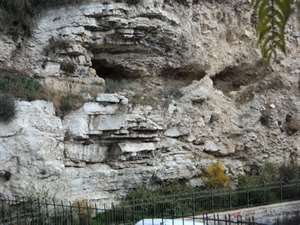
Jerusalem where Jesus was crucified

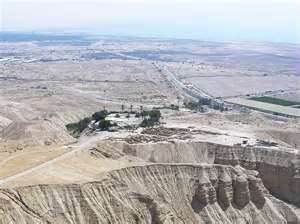

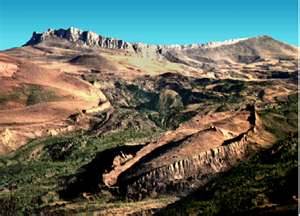
the Turkish government near Mt. Ararat, Turkey
Chapter 3
Amazing Archeological Discoveries
You alone are the Lord; You have made heaven, the heaven of heavens, with all their host, the earth and everything on it, the seas and all that is in them, and You preserve them all. The host of heaven worships You. (Nehemiah 9: 6)
In the last two centuries, many great archeological discoveries have been made that attest to the validity and truth of the Holy Bible. In this respect, most of these discoveries are found in the Middle East where these events occurred. However, it was not until the rebirth of Israel on May 14, 1948 that scholarly research began to increase at a frantic pace to ascertain the associations made in the Bible with historical sites that are primarily found in Israel. For example, one of the greatest discoveries recently made is that of the Dead Sea Scrolls which a chapter in this book is specifically devoted to, so significant is it. And recent archeological excavations in the town of Jericho by Dr. Bryant Wood, Director of the Associates for Biblical Research, had this to say about the Jericho site….”The evidence is already in. Three major expeditions to the site (Jericho) over the past 90 years uncovered abundant evidence to support the Biblical account (fallen walls).”1 However, it is not within the scope of this book to present a cross section of all the significant archeological discoveries that have been made. If we were to do so, it would render this book much too large to give proper treatment to the other chapters presented. Instead I would like to focus in on the amazing discoveries made by a God appointed man by the name of Biblical archeologist Ron Wyatt. The discoveries made by Ron of: Noah’s Ark, the Route of the Exodus and the discovery of Sodom and Gomorrah are truly monumental. These discoveries made by Ron give incredible validity for the Bible as you will read.
Noah’s Ark Discovered
On June 20, 1987 the Turkish government announced to the world the discovery of Noah’s Ark and dedicated it and the surrounding area as a national park, naming it the Park of “Noah’s Big Boat”. This came about after many years of research by a man by the name of Ron Wyatt. Six months earlier, on Feb. 1987, the Turkish Ministry of Foreign Affairs and researchers from Ataturk University of Turkey made the official decision that the “boat-shaped formation” were the actual remains of Noah’s Ark. During this special ceremony, Ron Wyatt was honored as the “discoverer” of the formation determined to be the remains of Noah’s Ark.2
In Sept. 1960, 27 year old Ron Wyatt stared at an aerial photograph of what appeared to be a boat shaped object in the September issue of Life Magazine. A Turkish army captain, routinely examining aerial photographs, saw a picture of what looked like a boat on a mountain 20 miles south of Mt. Ararat, the presumed biblical landfall of Noah’s Ark. The boat-shaped form was about 500 ft. long which was identical to 300 Royal Egyptian cubits, the dimensions given in Genesis 6:15 of Noah’s Ark (one Royal Egyptian cubit equals 20.6 inches). Upon this discovery, an American exploration team was assembled and sent to investigate the site. When they arrived at the site, they determined that there was no visible evidence to conclude the existence of an ancient ship. Though the Life article stated that a complete excavation would be made the following year, the world never heard about this site again until Ron Wyatt continued with his investigation there.
Between 1960 and 1977, Ron Wyatt studied all he could about archeology, fluid dynamics, volcanoes and the Biblical account of the Ark and its journey. He came to the conclusion that the “boat-shaped” object located by the Turkish Air Force captain was the most likely place the Ark could have landed. First, he felt any wooden boat located on the actual slopes of Mt. Ararat could not possibly have survived the volcanic action of such a mountain. Besides being consumed by fire through lava flows, Mt. Ararat has experienced explosive eruptions similar to Mt. St. Helen’s in its past. Anything like the Ark, made of wood, would have been destroyed a long time ago. However, he remembered reading in Genesis 8:4 that….
“And in the 7th month, on the 17th day of the month, the ark rested upon the mountains of Ararat.” (Gen 8:4)
Sodom and Gomorrah Found
During his numerous trips to research the Exodus route on the shores of the Gulf of Aqaba separating the Sinai Peninsula and Saudi Arabia, Ron visited the site of Masada in Israel. Masada is a magnificent former cliff top stronghold on top of a massive plateau situated a few miles from the southwestern shores of the Dead Sea. It is known for being one of Herod’s many palaces during the time of Christ and became a hideaway for him in his attempt to escape the Parthians in 40 B.C. After Jerusalem was destroyed in 70 A.D., Masada became the final stand of the Jewish Zealots against the Romans in A.D. 73. In order to reach Masada, a large contingency of Roman soldiers built a ramp of earth toward the top of the plateau. After scaling the remaining high wall, they found the remains of 960 Zealots, all having committed mass suicide instead of surrendering themselves to the Romans. After this event, Masada was once more manned by a Roman garrison, only to be soon abandoned to the elements.7 In the fifth century Masada was once more briefly occupied by Byzantine monks who dwelled among the rubble and caves. Again, it was abandoned once more, this time for nearly 1,400 years until it was exhaustively excavated during the winter months of 1963 and 1964 by an international team headed by Dr. Yigal Yadin of the Hebrew University of Jerusalem.8
As Ron looked almost 1,400 feet down from the top of Masada in 1989, he thought he was looking at the ruins of an ancient city. There were large rock edifices, arranged in distinct rectangular order, looking like the shapes of ancient city walls and buildings. Upon my own ascent to the top of Masada when I visited Israel, I looked towards the north from the cable car on the northwestern side of Masada and saw formations that appeared to have a great many saw tooth tops. I also was amazed at this unique formation and the expanse of whitish material which was very visible. When Ron visited the site in 1989, he too was impressed with the material which broke right off in his hands and disintegrated into particles like talcum powder. To him, it looked and felt like ash. In fact, he took some samples and had them tested at a number of laboratories. They all reported to him that it was ash.9
As Ron and his assistants walked down what they thought were gullies, it became apparent that they were walking down “avenues”, as these “gullies” communicated with each other. If they were only wadis, which is the Israeli term for gullies or dried creek beds, they would have been much more random as indicated by other wadis seen throughout Israel and the Middle East. Along these “avenues”, the research team saw large rock edifices that appeared to be walls common to ancient biblical construction. Of particular significance was the outside wall surrounding this area. It was “double-walled”, exactly like the Canaanite city walls that had been found at other excavated sites. Upon re-entering the area, an unusual shaped formation stood out that best conformed to the appearance of a sphinx. Then, not far from the sphinx shaped formation, an ancient ziggurat could be made out, with the remains of what once were wooden rafters still evident. A ziggurat is a tall multi-storied structure, resembling a large wedding cake, which has each succeeding upper story smaller than the one below. Wooden rafters constituted the ceilings of the room below and floor above, again indicative of common construction technique of the ancient Canaanites. Even a long platform area, perfectly symmetrical, could be made out at one end of the walled city to the other. It is identical to other temple sites of similar ancient cities such as biblical Sushan or Susa located in present day Iran. However, Ron wanted absolute proof that this site was Gomorrah.
Upon his next visit, Ron and Richard Rives, his associate, found the evidence that fulfilled this need to prove, beyond a shadow of a doubt, that this area was once the city of Gomorrah. They found brimstone! As they surveyed the area, they came upon a large chunk of ash that had fallen because of a recent rainstorm. Within this large chunk were numerous yellowish balls. Surrounding the yellowish balls was a reddish-black crystalline capsule of ash. Chemical analysis of the pods revealed a central core of 95.7% sulfur. Upon combustion, elements found in the pod when combined with the sulfur produced a fiery substance with temperatures reaching 4,000° – 5,000° F. Evidence for these extremely high temperatures could be seen in the reddish burn marks that formed the exterior crystalline layer of ash that accompanied each piece of brimstone. Brimstone found at the site varied in size from grains of sand to the size of softballs and were deposited in a random fashion, similar to that of rain. The quantity of brimstone found and its ability to produce extremely high temperatures provided the reason why the elements of this area were vitrified. As such, all substances were thermally ionized as indicated by the layering effect of the resultant ash specifically found in this area. It should be pointed out that no volcanic activity is noted at or near the site, thereby excluding the possibility that the sulfur originated from volcanoes. Additionally, sulfur in this type of configuration has never been found anywhere else in the world. With the finding of actual brimstone, Ron was convinced they had truly found Gomorrah.
The Jewish-Roman historian, Josephus Flavius, records the existence of Sodom and Gomorrah among the five cities of the plain to have been destroyed. His historical account of what occurred in this area is found in the “Wars of the Jews”, Book IV, Chapter VIII (see commentary to the right).
Just as Josephus writes that these five cities are still to be seen, Ron was able to find four of the five sites which were destroyed by the Lord God. These sites were Sodom, Gomorrah, Admah, Zeboiim, and Thar. In fact, a present day map of the region still notes the location of Thar (Zohar in Hebrew) and the location of Mt. Sodom, which is where Sodom is located. He wasn’t able to visit the fifth site because it was located in Jordan, which at the time was behind an electrified fence in the neutral zone between Israel and Jordan.
As one does a word study on Sodom and Gomorrah in both the Old and New Testaments, the most recent references regarding the cities were made by the Apostles Peter and Jude in the New Testament (see 2 Peter 2:6 on the next page). Is it not amazing that these cities of the plain were destroyed by fire unto ashes given as an example to those living ungodly lives? Is it not for such a time as this that the discovery of Sodom and Gomorrah and the other cities of the plain are being made known to the world this day, so that the ashes and brimstone discovered there are an actual witness and warning against those who today live ungodly lives as those in Sodom and Gomorrah did in their time?
It is very evident that sexual immorality of fornication, licentiousness and homosexuality played a great role in the condemnation of the cities of the plain by God. But the book of Ezekiel also reports that these cities were destroyed because of wanton richness which they hoarded for themselves and not willing to help the poor and needy.
The Lord has not only provided proof of His existence but also as testimony and example to this unbelieving generation. Therefore, this is a very real warning to those who are living ungodly lives, just as those who lived in the cities of the plain nearly 3,900 years ago. I consider this a true and sober warning to our country and the rest of the world that if it does not repent from its evil and wicked ways, the consequence of their ungodly lives will be similar to that which occurred in the cities of the plain as given in second scripture of 2 Peter 3:6 to the right. (NEXT PAGE)
Helping Our Mission
Although this web book is free of charge, we ask that if you are impacted by this work and its been a blessing to you, to consider offering a donation of any amount to help with our work and mission.
We believe a fair donation for this book is $10. However, we would be so blessed with any amount that the Lord places on your heart.
To give, just go to our DONATIONS LINK above . Thank You!
The text boxes below contain additional commentary or scripture references to the main body of the book. Other times they explain elements described in the main body of the book in greater detail for greater understanding and comprehension. However, it is not essential that they be read.
Numbers following text are footnote designations and can be looked up in our Bibliography and Footnote secton.

Noah's Ark in foreground, located on Cesna Dag, a mountain near the small town of Dobubeyazit, Turkey. The late Ron Wyatt is shown in front .
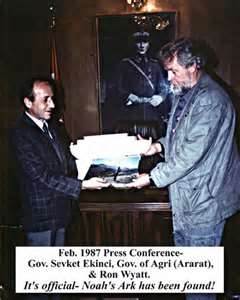
Ron Wyatt being awarded a replica of Noah's Ark from Gov. Sevket Ekinci, governor of the province of Ararat in Turkey. Also, Dr. Arkugal, dean of archeology at the University of Turkey agreed with Ron that the boat shaped formation was in fact Noah's Ark.
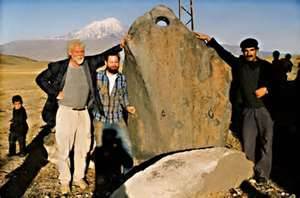
Ron on left noting droge anchor stones used to keep boat from capsizing. Mt. Ararat is seen in the background.

Location of deck support and wall timbers based on sub-surface radar scans.

Sub-surface radar and metal detector scans being performed over the interior of boat.
Larousse Encyclopedia Definition of Earth Conditions Prior the Flood
“There was, as we have already said, secondary bark and wood, similar to that of modern trees but lacking the spring and winter rings which correspond to seasonal alternation of moisture and dryness. This is further proof that the Carboniferous climate was fairly uniform.” (Pg. 369)

Location of Gomorrah, Israel as proven by the discovery of brimstone located at this site.

Masada near the Dead Sea
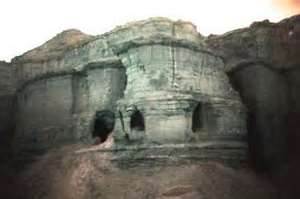
Possible ancient building found in Gomorrah.

Photo showing sulfur center encapsulated within crystalline exterior, colored red.

Sulfur separated out from the crystalline ash encasement.
“Wars of the Jews”, Book IV, Chapter VIII
“Now this country is then so sadly burnt up, that nobody cares to come at it;…It was of old a most happy land, both for the fruits it bore and the riches of its cities, although it be now all burnt up. It is related how for the impiety of its inhabitants, it was burnt by lighting; in consequence of which there are still the remainders of that divine fire; and the traces of the five cities are still to be seen,…”
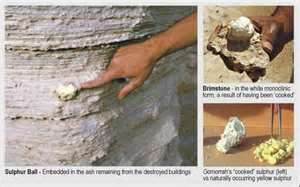
Sulfur balls imbedded in rock wall in Gomorrah. Encapsulated sulfur ball shown above on right and ash and sulfur separated in photo on right.
“If He did not spare the ancient world when he brought the flood on its ungodly people, but protected Noah, a preacher of righteousness, and seven others; if he condemned the cities of Sodom and Gomorrah by burning them to ashes and turning the cities of Sodom and Gomorrah into ashes condemned them with an overthrow (destruction), making them an ensample unto those that after should live ungodly.” (2 Peter 2:6)
“But the heavens and the earth, which are now, by the same word are kept in store, reserved unto fire against the day of judgment and perdition of ungodly men.” (2 Peter 3:6)